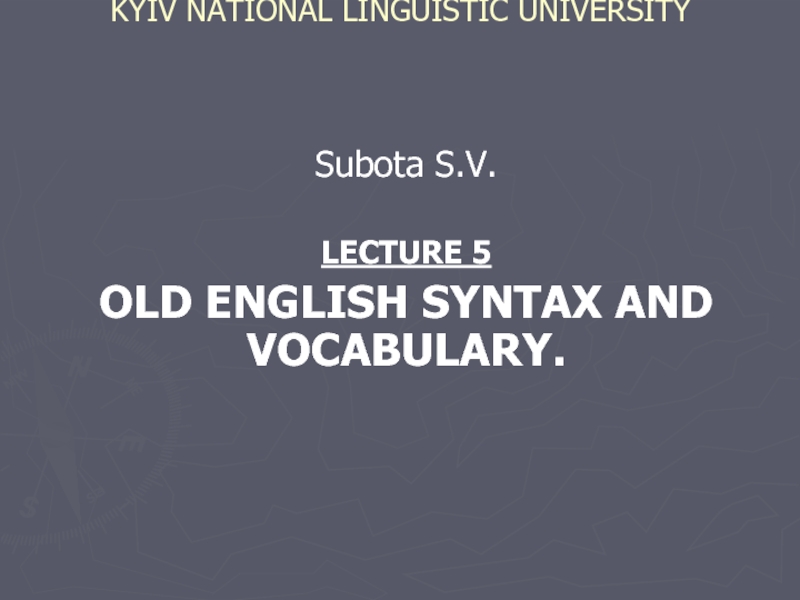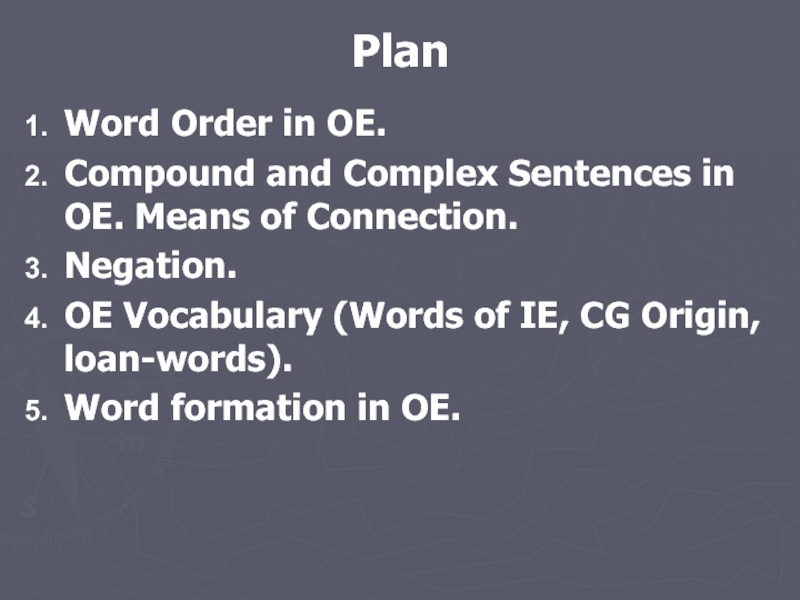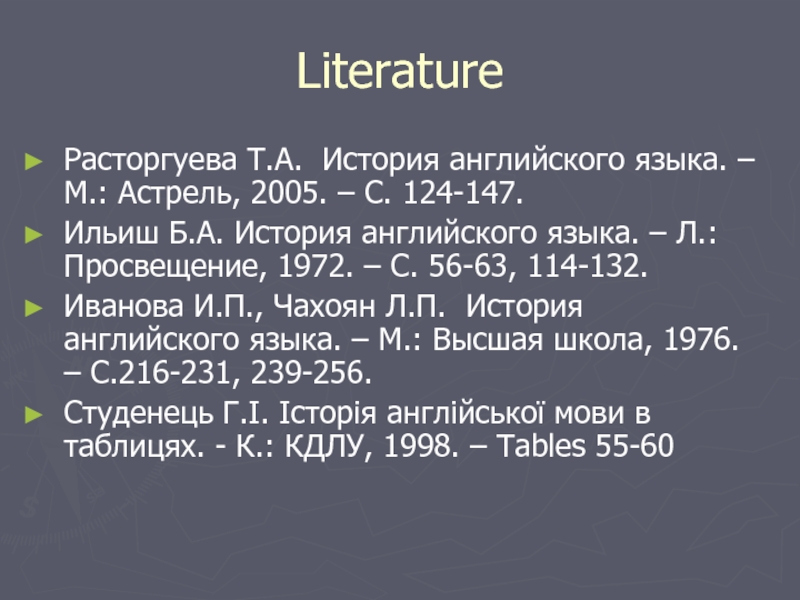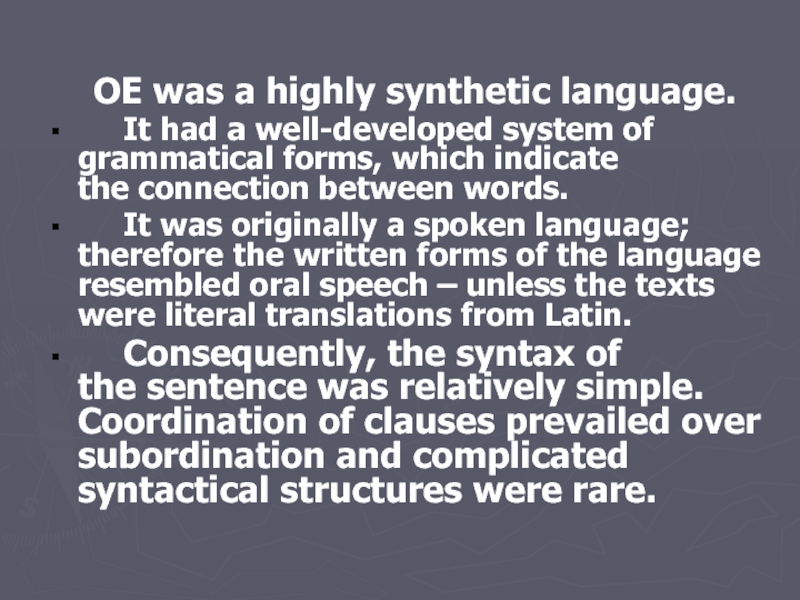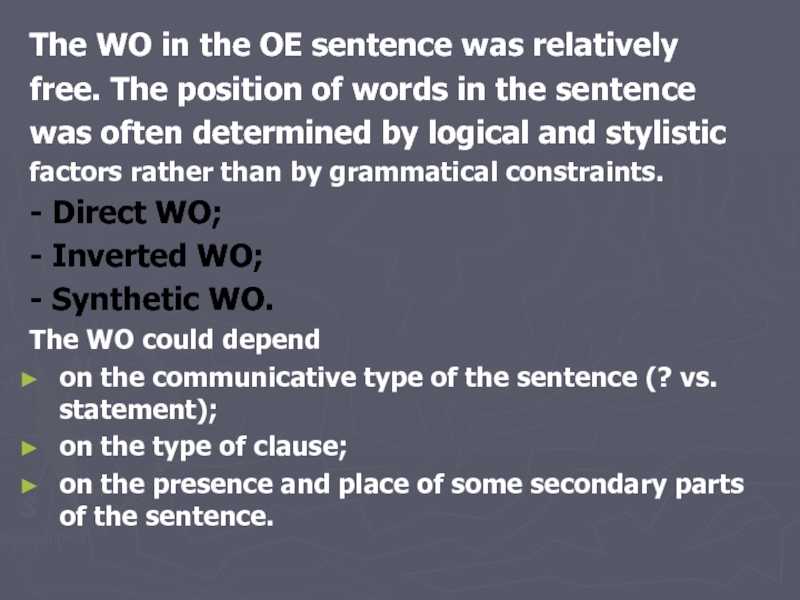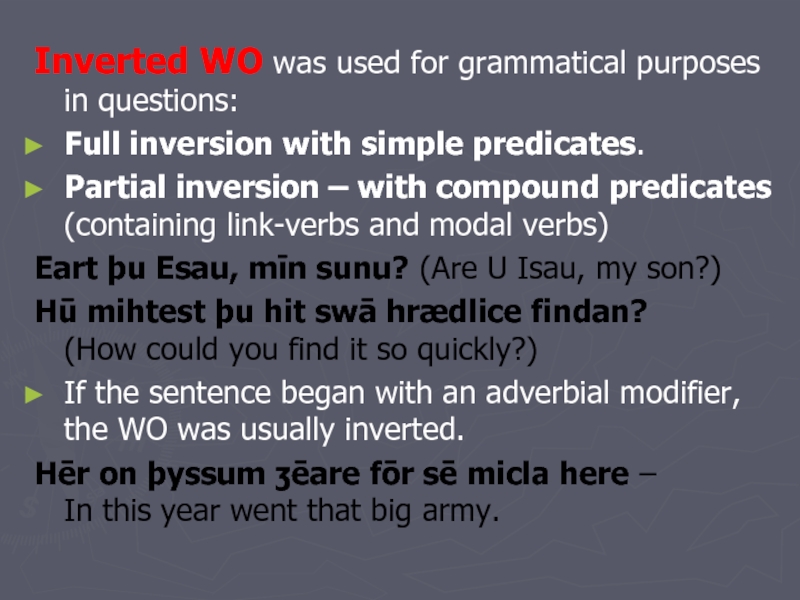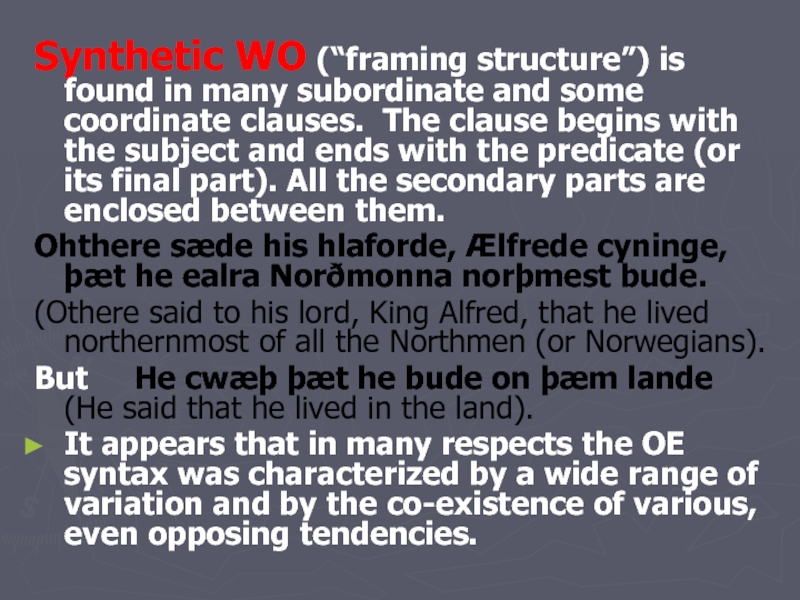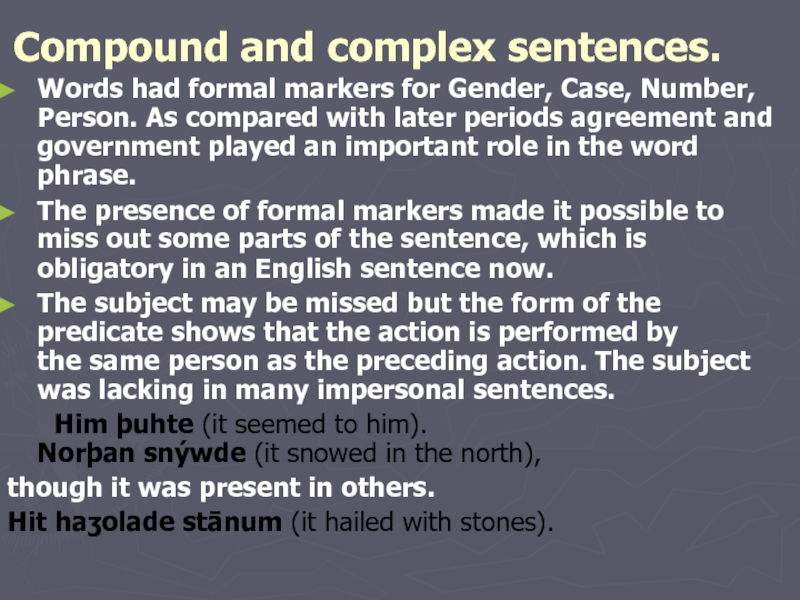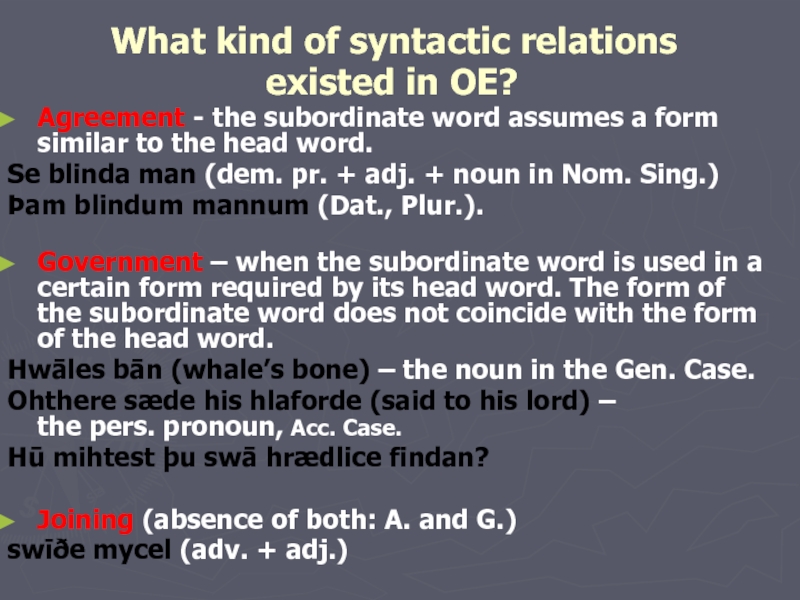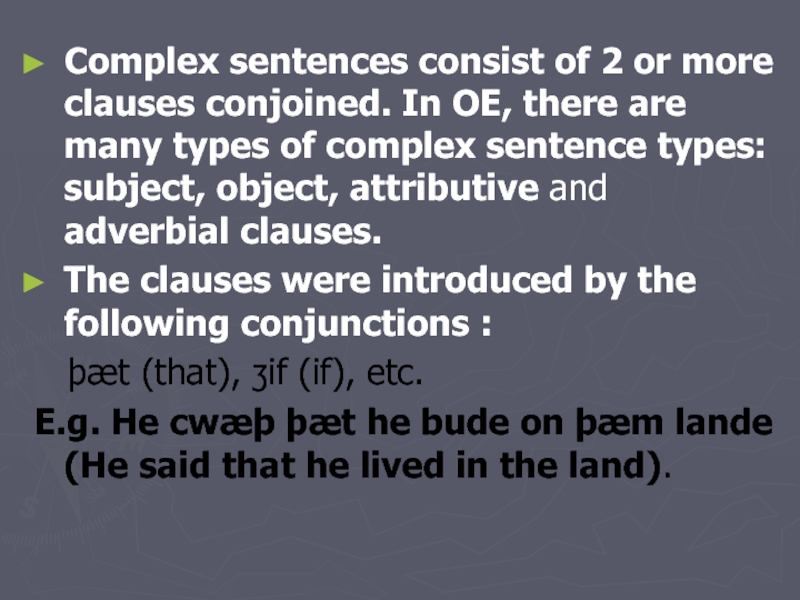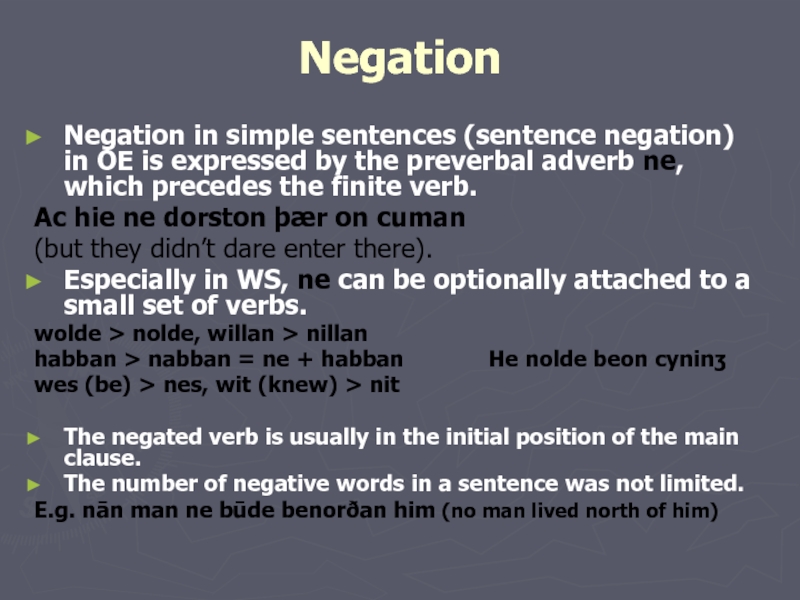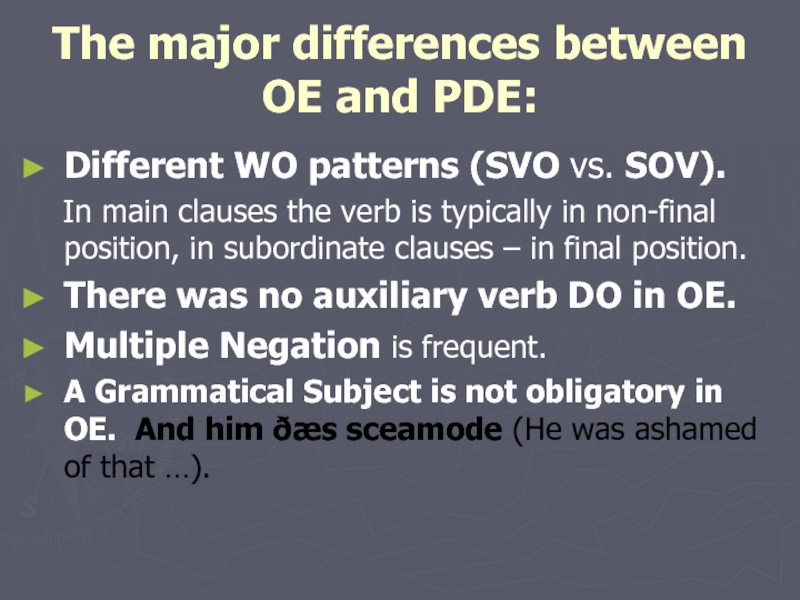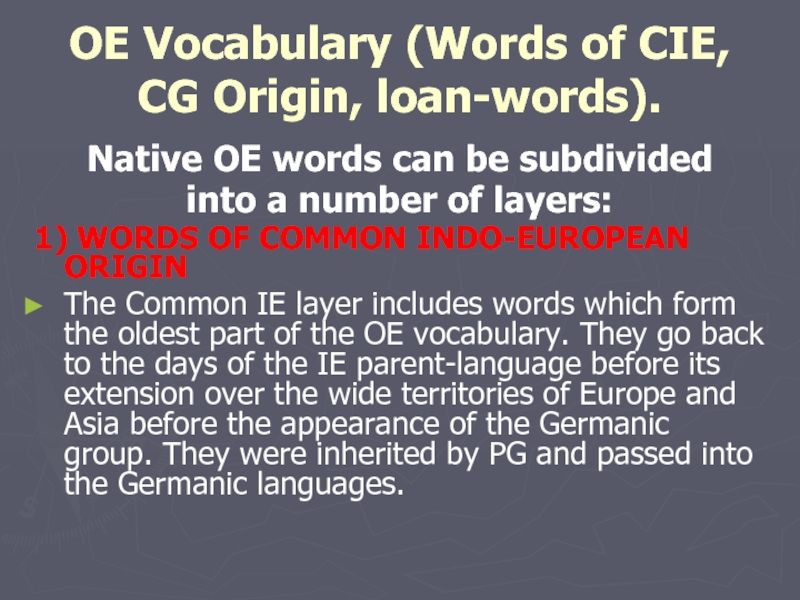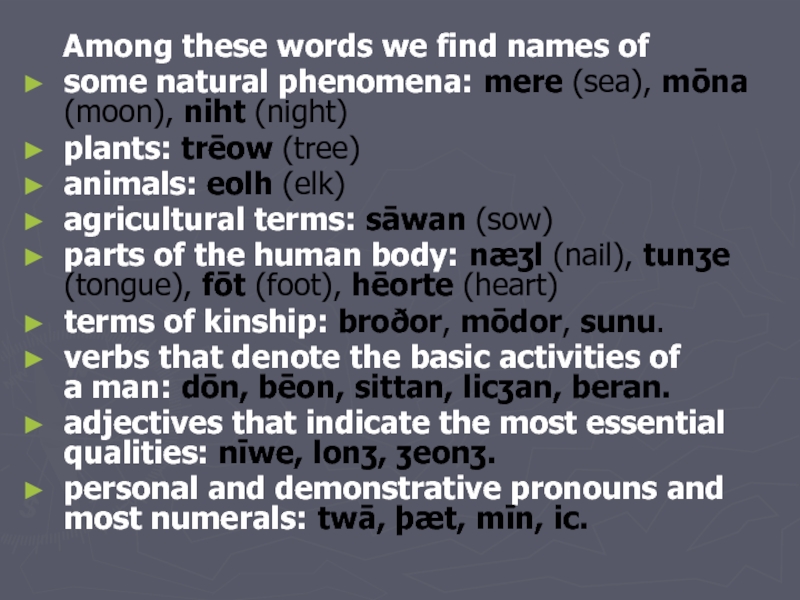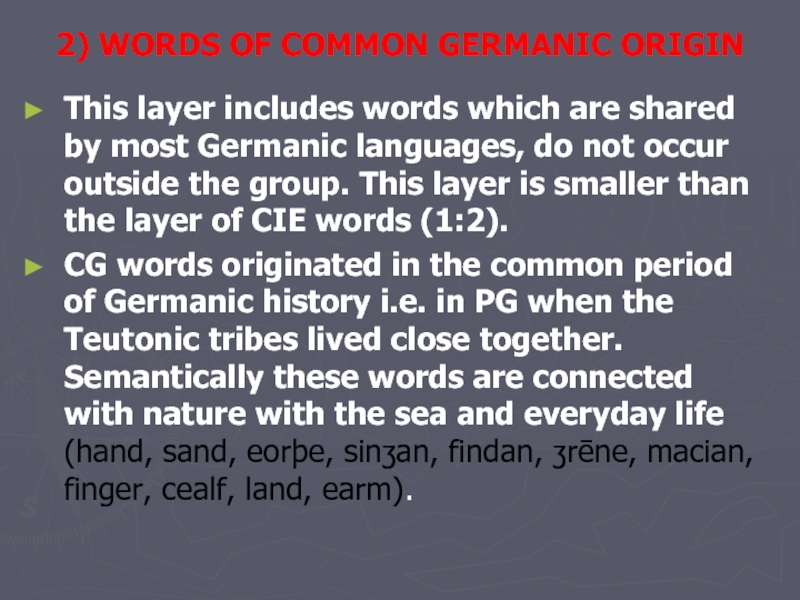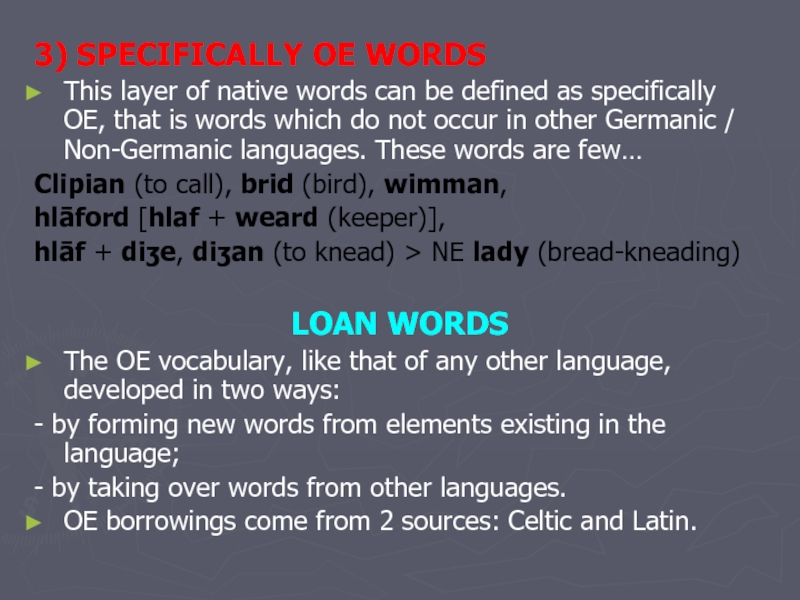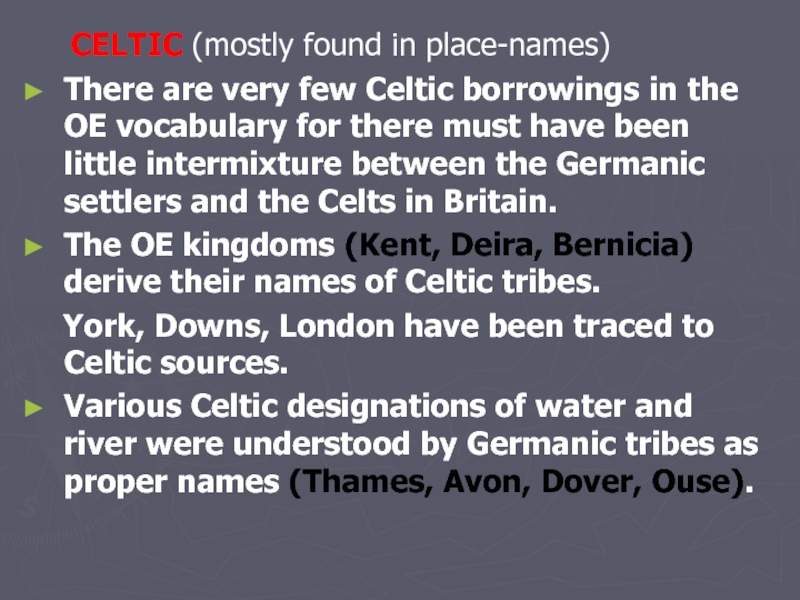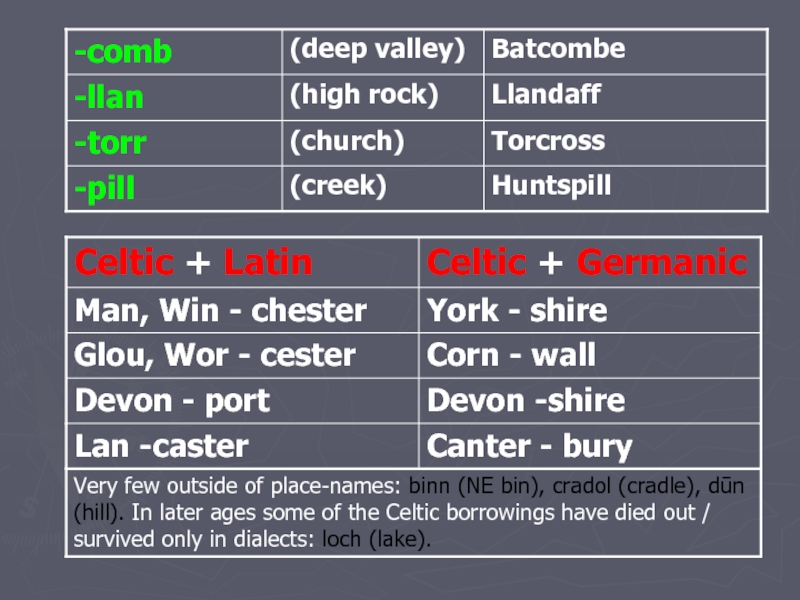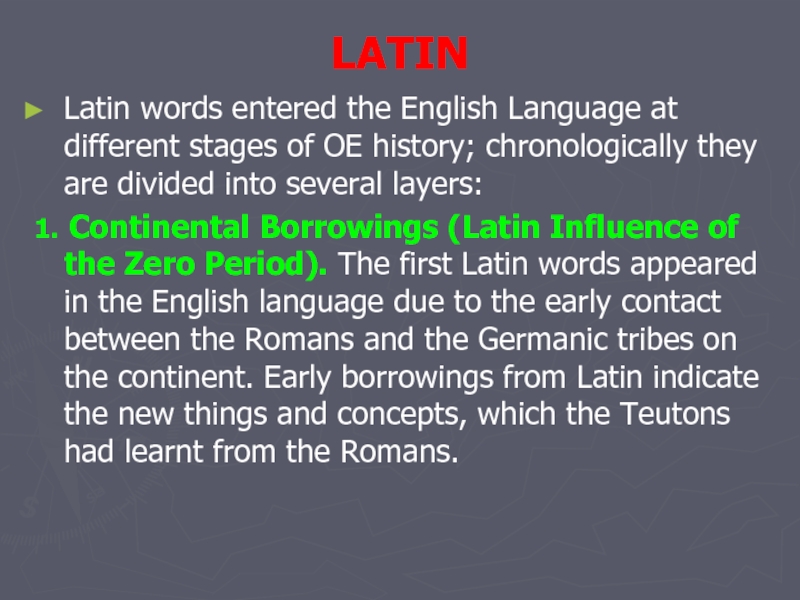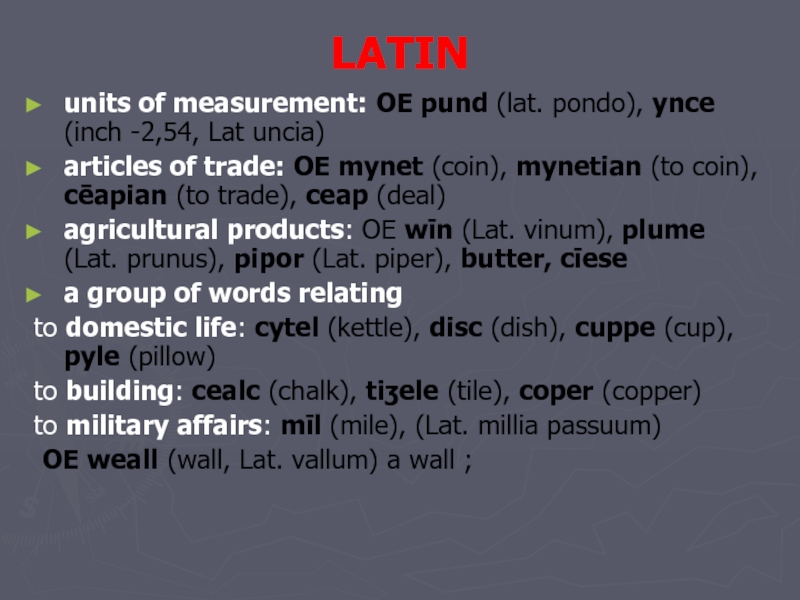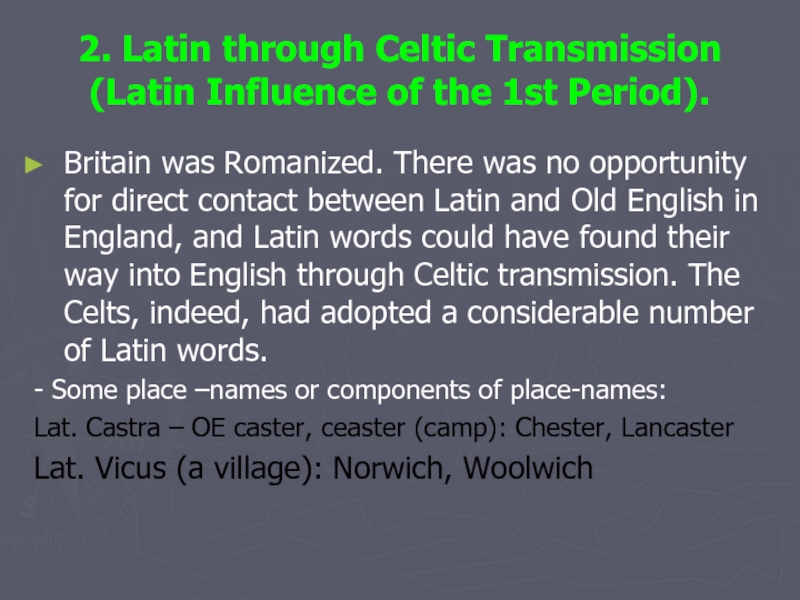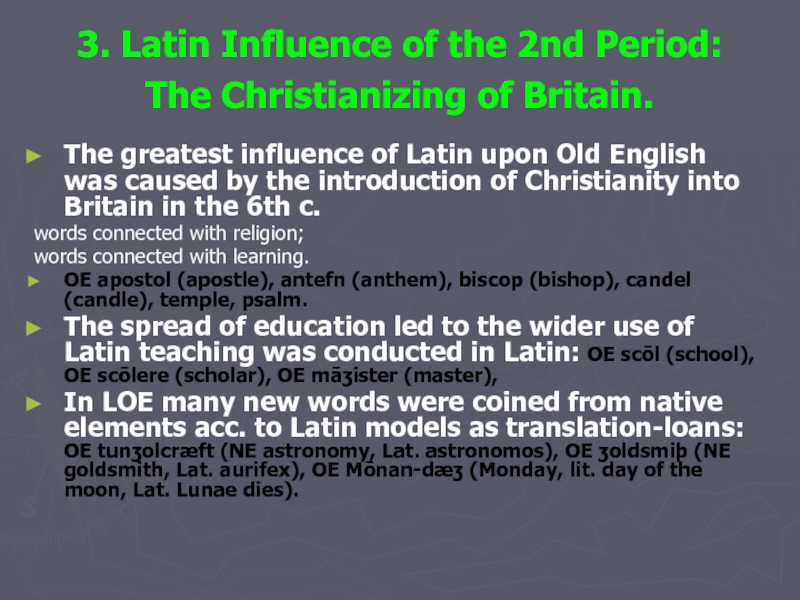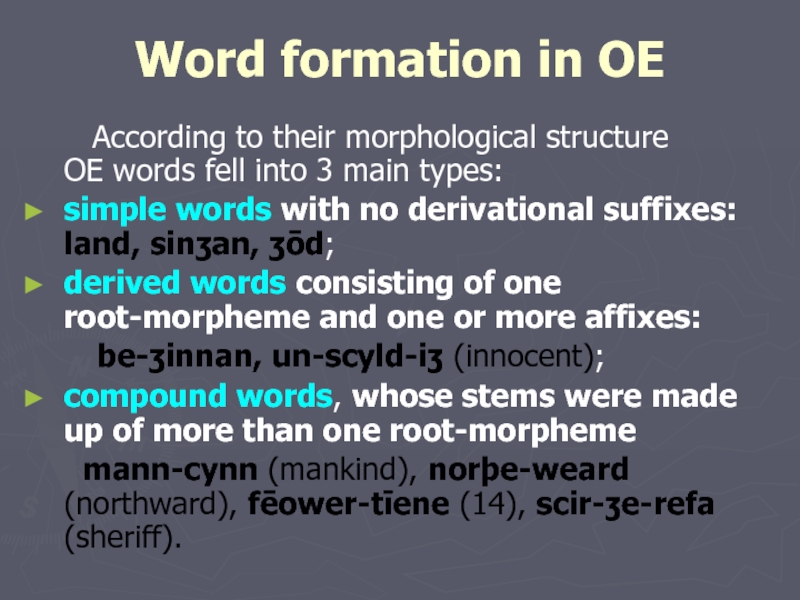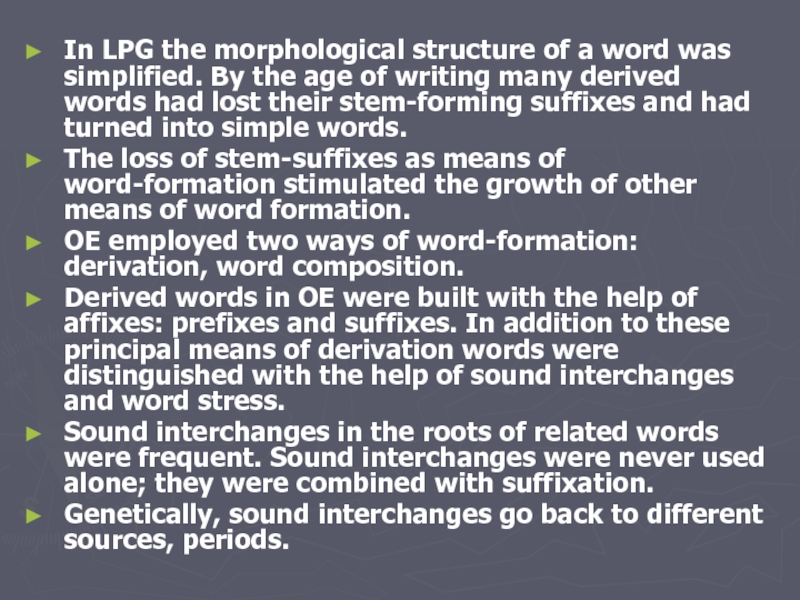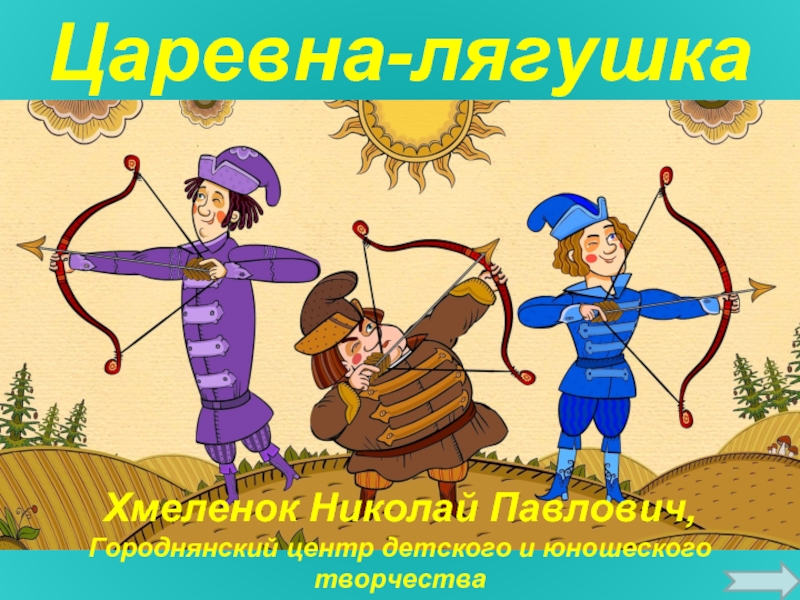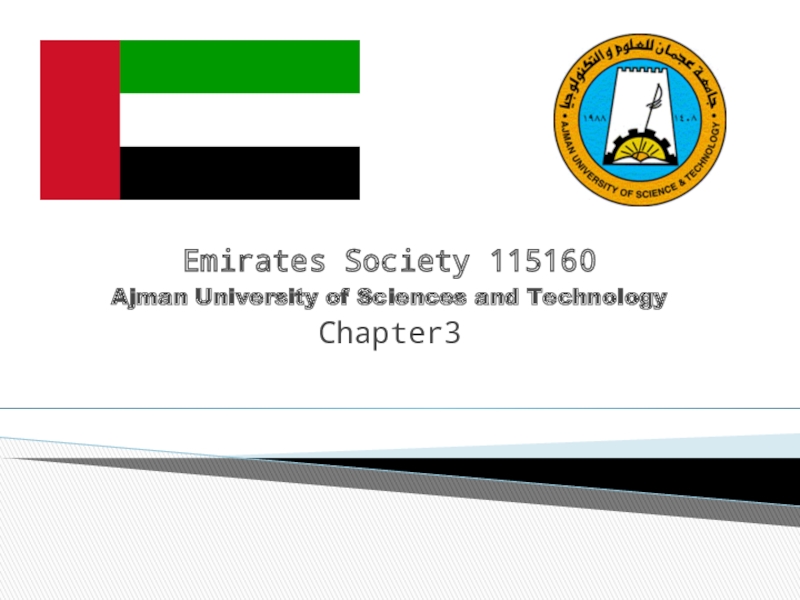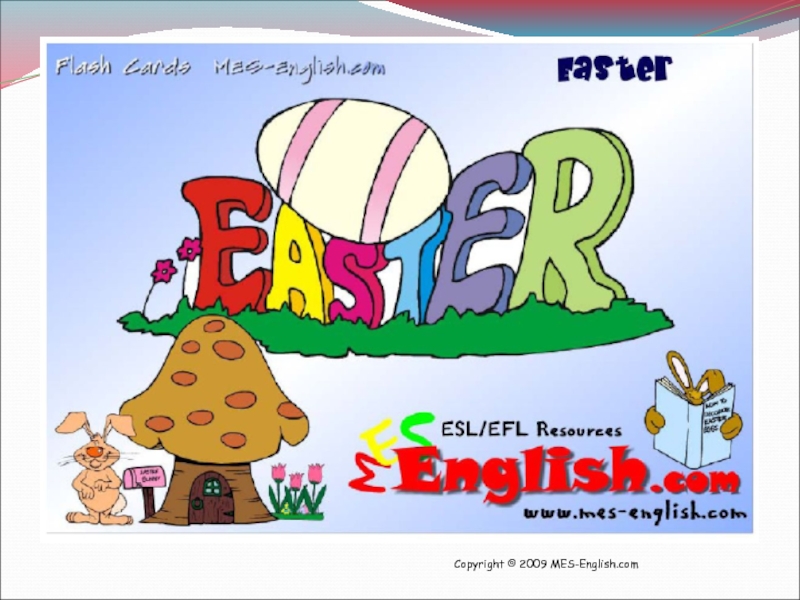- Главная
- Разное
- Дизайн
- Бизнес и предпринимательство
- Аналитика
- Образование
- Развлечения
- Красота и здоровье
- Финансы
- Государство
- Путешествия
- Спорт
- Недвижимость
- Армия
- Графика
- Культурология
- Еда и кулинария
- Лингвистика
- Английский язык
- Астрономия
- Алгебра
- Биология
- География
- Детские презентации
- Информатика
- История
- Литература
- Маркетинг
- Математика
- Медицина
- Менеджмент
- Музыка
- МХК
- Немецкий язык
- ОБЖ
- Обществознание
- Окружающий мир
- Педагогика
- Русский язык
- Технология
- Физика
- Философия
- Химия
- Шаблоны, картинки для презентаций
- Экология
- Экономика
- Юриспруденция
Lecture 5 old english syntax and vocabulary презентация
Содержание
- 1. Lecture 5 old english syntax and vocabulary
- 2. Plan Word Order in OE. Compound and
- 3. Literature Расторгуева Т.А. История английского языка. –
- 4. Word Order (WO) in OE
- 5. OE was
- 6. The WO in the OE sentence was
- 7. Inverted WO was used for grammatical purposes
- 8. Synthetic WO (“framing structure”) is found in
- 9. Compound and complex sentences. Words had
- 10. What kind of syntactic relations
- 11. Complex sentences consist of 2 or more
- 12. Negation Negation in simple sentences (sentence
- 13. The major differences between OE and PDE:
- 14. OE Vocabulary (Words of CIE, CG Origin,
- 15. Among these words we find
- 16. 2) WORDS OF COMMON GERMANIC ORIGIN
- 17. 3) SPECIFICALLY OE WORDS This layer of
- 18. CELTIC (mostly found in place-names)
- 20. LATIN Latin words entered the English
- 21. LATIN units of measurement: OE pund
- 22. 2. Latin through Celtic Transmission (Latin Influence
- 23. 3. Latin Influence of the 2nd Period:
- 24. Word formation in OE
- 25. In LPG the morphological structure of a
- 26. THANK YOU FOR YOUR ATTENTION!
Слайд 2Plan
Word Order in OE.
Compound and Complex Sentences in OE. Means of
Negation.
OE Vocabulary (Words of IE, CG Origin, loan-words).
Word formation in OE.
Слайд 3Literature
Расторгуева Т.А. История английского языка. – М.: Астрель, 2005. – С.
Ильиш Б.А. История английского языка. – Л.: Просвещение, 1972. – С. 56-63, 114-132.
Иванова И.П., Чахоян Л.П. История английского языка. – М.: Высшая школа, 1976. – С.216-231, 239-256.
Студенець Г.І. Історія англійської мови в таблицях. - К.: КДЛУ, 1998. – Tables 55-60
Слайд 5
OE was a highly synthetic language.
It was originally a spoken language; therefore the written forms of the language resembled oral speech – unless the texts were literal translations from Latin.
Consequently, the syntax of the sentence was relatively simple. Coordination of clauses prevailed over subordination and complicated syntactical structures were rare.
Слайд 6The WO in the OE sentence was relatively
free. The position of
was often determined by logical and stylistic
factors rather than by grammatical constraints.
- Direct WO;
- Inverted WO;
- Synthetic WO.
The WO could depend
on the communicative type of the sentence (? vs. statement);
on the type of clause;
on the presence and place of some secondary parts of the sentence.
Слайд 7Inverted WO was used for grammatical purposes in questions:
Full inversion with
Partial inversion – with compound predicates (containing link-verbs and modal verbs)
Eart þu Esau, mīn sunu? (Are U Isau, my son?)
Hū mihtest þu hit swā hrædlice findan? (How could you find it so quickly?)
If the sentence began with an adverbial modifier, the WO was usually inverted.
Hēr on þyssum ʒēare fōr sē micla here – In this year went that big army.
Слайд 8Synthetic WO (“framing structure”) is found in many subordinate and some
Ohthere sæde his hlaforde, Ælfrede cyninge, þæt he ealra Norðmonna norþmest bude.
(Othere said to his lord, King Alfred, that he lived northernmost of all the Northmen (or Norwegians).
But He cwæþ þæt he bude on þæm lande (He said that he lived in the land).
It appears that in many respects the OE syntax was characterized by a wide range of variation and by the co-existence of various, even opposing tendencies.
Слайд 9 Compound and complex sentences.
Words had formal markers for Gender, Case,
The presence of formal markers made it possible to miss out some parts of the sentence, which is obligatory in an English sentence now.
The subject may be missed but the form of the predicate shows that the action is performed by the same person as the preceding action. The subject was lacking in many impersonal sentences.
Him þuhte (it seemed to him). Norþan snýwde (it snowed in the north),
though it was present in others.
Hit haʒolade stānum (it hailed with stones).
Слайд 10 What kind of syntactic relations
existed in OE?
Agreement -
Se blinda man (dem. pr. + adj. + noun in Nom. Sing.)
Þam blindum mannum (Dat., Plur.).
Government – when the subordinate word is used in a certain form required by its head word. The form of the subordinate word does not coincide with the form of the head word.
Hwāles bān (whale’s bone) – the noun in the Gen. Case.
Ohthere sæde his hlaforde (said to his lord) – the pers. pronoun, Acc. Case.
Hū mihtest þu swā hrædlice findan?
Joining (absence of both: A. and G.)
swīðe mycel (adv. + adj.)
Слайд 11Complex sentences consist of 2 or more clauses conjoined. In OE,
The clauses were introduced by the following conjunctions :
þæt (that), ʒif (if), etc.
E.g. He cwæþ þæt he bude on þæm lande (He said that he lived in the land).
Слайд 12Negation
Negation in simple sentences (sentence negation) in OE is expressed by
Ac hie ne dorston þær on cuman
(but they didn’t dare enter there).
Especially in WS, ne can be optionally attached to a small set of verbs.
wolde > nolde, willan > nillan
habban > nabban = ne + habban He nolde beon cyninʒ
wes (be) > nes, wit (knew) > nit
The negated verb is usually in the initial position of the main clause.
The number of negative words in a sentence was not limited.
E.g. nān man ne būde benorðan him (no man lived north of him)
Слайд 13The major differences between OE and PDE:
Different WO patterns (SVO
In main clauses the verb is typically in non-final position, in subordinate clauses – in final position.
There was no auxiliary verb DO in OE.
Multiple Negation is frequent.
A Grammatical Subject is not obligatory in OE. And him ðæs sceamode (He was ashamed of that …).
Слайд 14OE Vocabulary (Words of CIE, CG Origin, loan-words).
Native OE words can
into a number of layers:
1) WORDS OF COMMON INDO-EUROPEAN ORIGIN
The Common IE layer includes words which form the oldest part of the OE vocabulary. They go back to the days of the IE parent-language before its extension over the wide territories of Europe and Asia before the appearance of the Germanic group. They were inherited by PG and passed into the Germanic languages.
Слайд 15 Among these words we find names of
some natural phenomena:
plants: trēow (tree)
animals: eolh (elk)
agricultural terms: sāwan (sow)
parts of the human body: næʒl (nail), tunʒe (tongue), fōt (foot), hēorte (heart)
terms of kinship: broðor, mōdor, sunu.
verbs that denote the basic activities of a man: dōn, bēon, sittan, licʒan, beran.
adjectives that indicate the most essential qualities: nīwe, lonʒ, ʒeonʒ.
personal and demonstrative pronouns and most numerals: twā, þæt, mīn, ic.
Слайд 16
2) WORDS OF COMMON GERMANIC ORIGIN
This layer includes words which
CG words originated in the common period of Germanic history i.e. in PG when the Teutonic tribes lived close together. Semantically these words are connected with nature with the sea and everyday life (hand, sand, eorþe, sinʒan, findan, ʒrēne, macian, finger, cealf, land, earm).
Слайд 173) SPECIFICALLY OE WORDS
This layer of native words can be defined
Clipian (to call), brid (bird), wimman,
hlāford [hlaf + weard (keeper)],
hlāf + diʒe, diʒan (to knead) > NE lady (bread-kneading)
LOAN WORDS
The OE vocabulary, like that of any other language, developed in two ways:
- by forming new words from elements existing in the language;
- by taking over words from other languages.
OE borrowings come from 2 sources: Celtic and Latin.
Слайд 18 CELTIC (mostly found in place-names)
There are very few Celtic
The OE kingdoms (Kent, Deira, Bernicia) derive their names of Celtic tribes.
York, Downs, London have been traced to Celtic sources.
Various Celtic designations of water and river were understood by Germanic tribes as proper names (Thames, Avon, Dover, Ouse).
Слайд 20LATIN
Latin words entered the English Language at different stages of
1. Continental Borrowings (Latin Influence of the Zero Period). The first Latin words appeared in the English language due to the early contact between the Romans and the Germanic tribes on the continent. Early borrowings from Latin indicate the new things and concepts, which the Teutons had learnt from the Romans.
Слайд 21LATIN
units of measurement: OE pund (lat. pondo), ynce (inch -2,54,
articles of trade: OE mynet (coin), mynetian (to coin), cēapian (to trade), ceap (deal)
agricultural products: OE wīn (Lat. vinum), plume (Lat. prunus), pipor (Lat. piper), butter, cīese
a group of words relating
to domestic life: cytel (kettle), disc (dish), cuppe (cup), pyle (pillow)
to building: cealc (chalk), tiʒele (tile), coper (copper)
to military affairs: mīl (mile), (Lat. millia passuum)
OE weall (wall, Lat. vallum) a wall ;
Слайд 222. Latin through Celtic Transmission (Latin Influence of the 1st Period).
Britain
- Some place –names or components of place-names:
Lat. Castra – OE caster, ceaster (camp): Chester, Lancaster
Lat. Vicus (a village): Norwich, Woolwich
Слайд 233. Latin Influence of the 2nd Period: The Christianizing of Britain.
The greatest influence of Latin upon Old English was caused by the introduction of Christianity into Britain in the 6th c.
words connected with religion;
words connected with learning.
OE apostol (apostle), antefn (anthem), biscop (bishop), candel (candle), temple, psalm.
The spread of education led to the wider use of Latin teaching was conducted in Latin: OE scōl (school), OE scōlere (scholar), OE māʒister (master),
In LOE many new words were coined from native elements acc. to Latin models as translation-loans: OE tunʒolcræft (NE astronomy, Lat. astronomos), OE ʒoldsmiþ (NE goldsmith, Lat. aurifex), OE Mōnan-dæʒ (Monday, lit. day of the moon, Lat. Lunae dies).
Слайд 24Word formation in OE
According to their morphological
simple words with no derivational suffixes: land, sinʒan, ʒōd;
derived words consisting of one root-morpheme and one or more affixes:
be-ʒinnan, un-scyld-iʒ (innocent);
compound words, whose stems were made up of more than one root-morpheme
mann-cynn (mankind), norþe-weard (northward), fēower-tīene (14), scir-ʒe-refa (sheriff).
Слайд 25In LPG the morphological structure of a word was simplified. By
The loss of stem-suffixes as means of word-formation stimulated the growth of other means of word formation.
OE employed two ways of word-formation: derivation, word composition.
Derived words in OE were built with the help of affixes: prefixes and suffixes. In addition to these principal means of derivation words were distinguished with the help of sound interchanges and word stress.
Sound interchanges in the roots of related words were frequent. Sound interchanges were never used alone; they were combined with suffixation.
Genetically, sound interchanges go back to different sources, periods.
